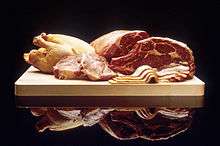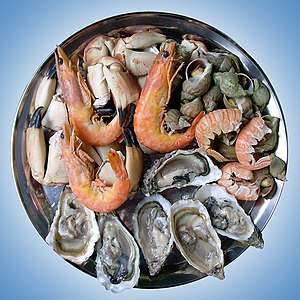Bison
Bison are large, even-toed ungulates in the genus Bison within the subfamily Bovinae.
| Bison | |
|---|---|
 | |
| American bison (Bison bison) | |
.jpg) | |
| European bison (Bison bonasus) | |
| Scientific classification | |
| Kingdom: | Animalia |
| Phylum: | Chordata |
| Class: | Mammalia |
| Order: | Artiodactyla |
| Family: | Bovidae |
| Subfamily: | Bovinae |
| Subtribe: | Bovina |
| Genus: | Bison Hamilton Smith, 1827 |
| Species | |
| |
Two extant and six extinct species are recognised. Of the six extinct species, five became extinct in the Quaternary extinction event. Bison palaeosinensis evolved in the Early Pleistocene in South Asia, and was the evolutionary ancestor of B. priscus (steppe bison), which was the ancestor of all other Bison species. From 2 million years ago to 6,000 BC, steppe bison ranged across the mammoth steppe, inhabiting Europe and northern Asia with B. schoetensacki (woodland bison), and North America with B. antiquus, B. latifrons, and B. occidentalis. The last species to go extinct, B. occidentalis, was succeeded at 3,000 BC by B. bison.
Of the two surviving species, the American bison, B. bison, found only in North America, is the more numerous. Although commonly known as a buffalo in the United States and Canada,[2] it is only distantly related to the true buffalo. The North American species is composed of two subspecies, the Plains bison, B. b. bison, and the wood bison, B. b. athabascae, which is the namesake of Wood Buffalo National Park in Canada. A third subspecies, the eastern bison (B. b. pennsylvanicus) is no longer considered a valid taxon, being a junior synonym of B. b. bison.[3] References to "woods bison" or "wood bison" from the eastern United States confusingly refer to this subspecies, not B. b. athabascae, which was not found in the region. The European bison, B. bonasus, or wisent, is found in Europe and the Caucasus, reintroduced after being extinct in the wild.
While all bison species are classified in their own genus, they are sometimes bred with domestic cattle (genus Bos) and produce sometimes fertile offspring called beefalo or zubron.
Description
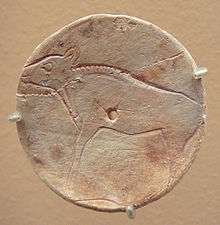
The American bison and the European bison (wisent) are the largest surviving terrestrial animals in North America and Europe. They are typical artiodactyl (cloven hooved) ungulates, and are similar in appearance to other bovines such as cattle and true buffalo. They are broad and muscular with shaggy coats of long hair. Adults grow up to 2 metres (6 feet 7 inches) in height and 3.5 m (11 ft 6 in) in length for American bison[4][5] and up to 2.1 m (6 ft 11 in) in height[6] and 2.9 m (9 ft 6 in) in length for European bison.[7] American bison can weigh from around 400 to 1,270 kilograms (880 to 2,800 pounds)[5][8] and European bison can weigh from 800 to 1,000 kg (1,800 to 2,200 lb).[7] European bison tend to be taller than American bison.
Bison are nomadic grazers and travel in herds. The bulls leave the herds of females at two or three years of age, and join a herd of males, which are generally smaller than female herds. Mature bulls rarely travel alone. Towards the end of the summer, for the reproductive season, the sexes necessarily commingle.[9]
American bison are known for living in the Great Plains, but formerly had a much larger range, including much of the eastern United States and parts of Mexico. Both species were hunted close to extinction during the 19th and 20th centuries, but have since rebounded; the wisent owing its survival, in part, to the Chernobyl disaster, as the Chernobyl Exclusion Zone has become a kind of wildlife preserve for wisent and other rare megafauna such as the Przewalski's horse, though poaching has become a threat in recent years.[10] The American Plains bison is no longer listed as endangered, but this does not mean the species is secure. Genetically pure B. b. bison currently number only about 20,000, separated into fragmented herds—all of which require active conservation measures.[11] The wood bison is on the endangered species list in Canada[12] and is listed as threatened in the United States, though numerous attempts have been made by beefalo ranchers to have it entirely removed from the Endangered Species List.[13]
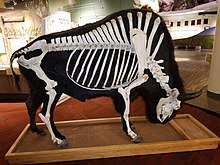
Although superficially similar, physical and behavioural differences exist between the American and European bison. The American species has 15 ribs, while the European bison has 14. The American bison has four lumbar vertebrae, while the European has five.[14] (The difference in this case is that what would be the first lumbar vertebra has ribs attached to it in American bison and is thus counted as the 15th thoracic vertebra, compared to 14 thoracic vertebrae in wisent.) Adult American bison are less slim in build and have shorter legs.[15] American bison tend to graze more, and browse less than their European relatives. Their anatomies reflect this behavioural difference; the American bison's head hangs lower than the European's. The body of the American bison is typically hairier, though its tail has less hair than that of the European bison. The horns of the European bison point through the plane of their faces, making them more adept at fighting through the interlocking of horns in the same manner as domestic cattle, unlike the American bison, which favours butting.[16] American bison are more easily tamed than their European cousins, and breed with domestic cattle more readily.[17]
Evolution and genetic history
The bovine tribe (Bovini) split about 5 to 10 million years ago into the buffalos (Bubalus and Syncerus) and a group leading to bison and taurine cattle.[18] Thereafter, the family lineage of bison and taurine cattle does not appear to be a straightforward "tree" structure as is often depicted in much evolution, because evidence of interbreeding and crossbreeding is seen between different species and members within this family, even many millions of years after their ancestors separated into different species. This crossbreeding was not sufficient to conflate the different species back together, but it has resulted in unexpected relationships between many members of this group, such as yak being related to American bison, when such relationships would otherwise not be apparent.
A 2003 study of mitochondrial DNA indicated four distinct maternal lineages in tribe Bovini:
However, Y chromosome analysis associated wisent and American bison.[20] An earlier study using amplified fragment length polymorphism fingerprinting showed a close association of wisent with American bison, and probably with the yak, but noted that the interbreeding of Bovini species made determining relationships problematic.[21]
The genus Bison diverged from the lineage that led to cattle (Bos primigenius) at the Plio-Pleistocene boundary in South Asia.[22] Two extant and six extinct species are recognised. Of the six extinct species, five went extinct in the Quaternary extinction event. Three were North American endemics: Bison antiquus, B. latifrons, and B. occidentalis. The fourth, B. priscus (steppe bison), ranged across steppe environments from Western Europe, through Central Asia, East Asia including Japan,[23][24] and onto North America. The fifth, B. schoetensacki. (woodland bison), inhabited Eurasian forests, extending from western Europe to the south of Siberia.[25]
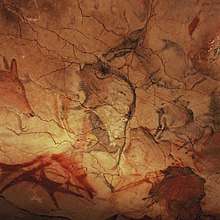
The sixth, B. palaeosinensis, evolving in the Early Pleistocene in South Asia,[22] is presumed to have been the evolutionary ancestor of B. priscus and all successive Bison lineages.[26] The steppe bison (B. priscus) evolved from Bison palaeosinensis in the Early Pleistocene. B. priscus is seen clearly in the fossil record around 2 million years ago.[27] The steppe bison spread across Eurasia, and all proceeding contemporary and successive species are believed to have derived from the steppe bison. Going extinct around 6,000 BCE in Siberia and around 5,400 BCE in Alaska,[28] [29] outlasted only by B. occidentalis, B. bonasus and B. bison, the steppe bison was the predominant bison pictured in the ancient cave paintings of Spain and Southern France.
The modern European bison is likely to have arisen from the steppe bison. There is no direct fossil evidence of successive species between the steppe bison and the European bison, though there are three possible lines of ancestry pertaining to the European wisent. Past research has suggested that the European bison is descended from bison that had migrated from Asia to North America, and then back to Europe, where they crossbred with existing steppe bison.[27] However, more recent phylogenetic research points to an origin either from the phenotypically and genetically similar Pleistocene woodland bison (B. schoetensacki)[25] or as the result of an interbreeding event between the steppe bison and the aurochs (Bos primigenius), the ancestor of domesticated cattle, around 120,000 years ago.[30] The possible hybrid is referred to in vernacular as the 'Higgs bison' as a hat-tip to the discovery process of the Higgs boson.[31]
At one point, some steppe bison crossbred with the ancestors of the modern yak. After that crossbreeding, a population of steppe bison crossed the Bering Land Bridge to North America. The steppe bison spread through the northern parts of North America and lived in Eurasia until around 11,000 years ago[32] and North America until 4,000 to 8,000 years ago.[27]
The Pleistocene woodland bison (B. schoetensacki) evolved in the Middle Pleistocene from B. priscus, and tended to inhabit the dry conifer forests and woodland which lined the mammoth steppe, occupying a range from western Europe to the south of Siberia. Although their fossil records are far rarer than their antecedent, they are thought to have existed until at least 36,000 BCE.[22][25]
Bison latifrons (the "giant" or "longhorn" bison) is thought to have evolved in midcontinent North America from B. priscus, after the steppe bison crossed into North America.[33][34][35] Giant bison (B. latifrons) appeared in the fossil record about 120,000 years ago.[27] B. latifrons was one of many species of North American megafauna that became extinct during the transition from the Pleistocene to the Holocene epoch (an event referred to as the Quaternary extinction event). It is thought to have disappeared some 21,000–30,000 years ago, during the late Wisconsin glaciation.[36]
B. latifrons co-existed with the slightly smaller B. antiquus for over 100,000 years. Their predecessor, the steppe bison appeared in the North American fossil record around 190,000 years ago.[37] B. latifrons is believed to have been a more woodland-dwelling, non-herding species, while B. antiquus was a herding grassland-dweller, very much like its descendant B. bison.[38] B. antiquus gave rise to both B. occidentalis, and later B. bison, the modern American bison, some 5,000 to 10,000 years ago.[39][40] B. antiquus was the most common megafaunal species on the North American continent during much of the Late Pleistocene and is the most commonly found large animal found at the La Brea Tar Pits.[41]
In 2016, DNA extracted from Bison priscus fossil remains beneath a 130,000-year-old volcanic ashfall in the Yukon suggested recent arrival of the species. That genetic material indicated that all American bison had a common ancestor 135,000 to 195,000 years ago, during which period the Bering Land Bridge was exposed; this hypothesis precludes an earlier arrival. The researchers sequenced mitochondrial genomes from both that specimen and from the remains of a recently discovered, estimated 120,000-year-old giant, long-horned, B. latifrons from Snowmass, Colorado. The genetic information also indicated that a second, Pleistocene migration of bison over the land bridge occurred 21,000 to 45,000 years ago.[42][43]
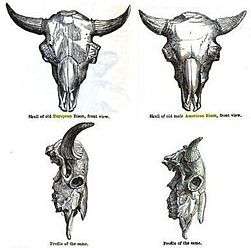
During the population bottleneck, after the great slaughter of American bison during the 19th century, the number of bison remaining alive in North America declined to as low as 541. During that period, a handful of ranchers gathered remnants of the existing herds to save the species from extinction. These ranchers bred some of the bison with cattle in an effort to produce "cattleo"[44] (today called "beefalo") Accidental crossings were also known to occur. Generally, male domestic bulls were crossed with buffalo cows, producing offspring of which only the females were fertile. The crossbred animals did not demonstrate any form of hybrid vigor, so the practice was abandoned. Wisent-American bison hybrids were briefly experimented with in Germany (and found to be fully fertile) and a herd of such animals is maintained in Russia. A herd of cattle-wisent crossbreeds (zubron) is maintained in Poland. First-generation crosses do not occur naturally, requiring caesarean delivery. First-generation males are infertile. The U.S. National Bison Association has adopted a code of ethics that prohibits its members from deliberately crossbreeding bison with any other species. In the United States, many ranchers are now using DNA testing to cull the residual cattle genetics from their bison herds. The proportion of cattle DNA that has been measured in introgressed individuals and bison herds today is typically quite low, ranging from 0.56 to 1.8%.[44][45]
There are also remnant purebred American bison herds on public lands in North America. Herds of importance are found in Yellowstone National Park, Wind Cave National Park in South Dakota, Blue Mounds State Park in Minnesota, Elk Island National Park in Alberta, and Grasslands National Park in Saskatchewan. In 2015, a purebred herd of 350 individuals was identified on public lands in the Henry Mountains of southern Utah via genetic testing of mitochondrial and nuclear DNA.[46] This study, published in 2015, also showed the Henry Mountains bison herd to be free of brucellosis, a bacterial disease that was imported with non-native domestic cattle to North America.[47]
Behavior
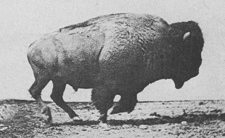

Wallowing is a common behavior of bison. A bison wallow is a shallow depression in the soil, either wet or dry. Bison roll in these depressions, covering themselves with mud or dust. Possible explanations suggested for wallowing behavior include grooming behavior associated with moulting, male-male interaction (typically rutting behavior), social behavior for group cohesion, play behavior, relief from skin irritation due to biting insects, reduction of ectoparasite load (ticks and lice), and thermoregulation.[48] In the process of wallowing, bison may become infected by the fatal disease anthrax, which may occur naturally in the soil.[49]
Bison temperament is often unpredictable. They usually appear peaceful, unconcerned, even lazy, yet they may attack anything, often without warning or apparent reason. They can move at speeds up to 56 km/h (35 mph) and cover long distances at a lumbering gallop.[50]
Their most obvious weapons are the horns borne by both males and females, but their massive heads can be used as battering rams, effectively using the momentum produced by what is a typical weight of 900 to 1,200 kilograms (2,000 to 2,700 lb) moving at 50 km/h (30 mph). The hind legs can also be used to kill or maim with devastating effect. In the words of early naturalists, they were dangerous, savage animals that feared no other animal and in prime condition could best any foe[50] (except for wolves and brown bears[9][51]).
The rutting, or mating, season lasts from June through September, with peak activity in July and August. At this time, the older bulls rejoin the herd, and fights often take place between bulls. The herd exhibits much restlessness during breeding season. The animals are belligerent, unpredictable, and most dangerous.[50]
Habitat
.jpg)
American bison live in river valleys, and on prairies and plains. Typical habitat is open or semiopen grasslands, as well as sagebrush, semiarid lands, and scrublands. Some lightly wooded areas are also known historically to have supported bison. They also graze in hilly or mountainous areas where the slopes are not steep. Though not particularly known as high-altitude animals, bison in the Yellowstone Park bison herd are frequently found at elevations above 8,000 feet and the Henry Mountains bison herd is found on the plains around the Henry Mountains, Utah, as well as in mountain valleys of the Henry Mountains to an altitude of 10,000 feet.
European bison tend to live in lightly wooded to fully wooded areas and areas with increased shrubs and bushes, though they can also live on grasslands and plains.
Restrictions
Throughout most of their historical range, landowners have sought restrictions on free-ranging bison. Herds on private land are required to be fenced in.[52] In the state of Montana, free-ranging bison on public lands may be shot, due to concerns about transmission of disease to cattle and damage to public property.[53] In 2013, Montana legislative measures concerning the bison were proposed and passed the legislature, but opposed by Native American tribes as they impinged on sovereign tribal rights. Three such bills were vetoed by Steve Bullock, the governor of Montana. The bison's circumstances remain an issue of contention between Native American tribes and private landowners.[54]
Diet
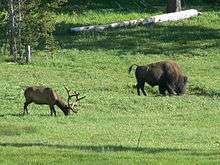
Bison are ruminants, which gives them the ability to ferment plants in a specialized stomach prior to digesting them. Bison were once thought to almost exclusively consume grasses and sedges, but are now known to consume a wide-variety of plants including woody plants and herbaceous eudicots.[55][56] Over the course of the year, bison shift which plants they select in their diet based on which plants have the highest protein or energy concentrations at a given time and will reliably consume the same species of plants across years.[55] Protein concentrations of the plants they eat tend to be highest in the spring and decline thereafter, reaching their lowest in the winter.[55] In Yellowstone National Park, bison browsed willows and cottonwoods, not only in the winter when few other plants are available, but also in the summer.[57] Bison are thought to migrate to optimize their diet,[58] and will concentrate their feeding on recently burned areas due to the higher quality forage the regrows after the burn.[59] Wisent tend to browse on shrubs and low-hanging trees more often than do the American bison, which prefer grass to shrubbery and trees.[60]
Reproduction
Female bison typically do not reproduce until three years of age[61] and can reproduce to at least 19 years of age.[62] Female bison can produce calves annually as long as their nutrition is sufficient, but will not give birth to a calf after years where weight gain was too low. A mother's probability of reproduction the following year is strongly dependent on the mother's mass and age.[62] Heavier female bison produce heavier calves (weighed in the fall at weaning) than light mothers, while the weight of calves is lower for older mothers (after age 8).[62]
Predators

Owing to their size, bison have few predators. Five notable exceptions are humans, grey wolves, cougars, brown bears, and coyotes.[63] The grey wolf generally takes down a bison while in a pack, but cases of a single wolf killing bison have been reported.[51] Brown bears also consume bison, often by driving off the pack and consuming the wolves' kill.[9] Brown bears and coyotes also prey on bison calves. Historically and prehistorically, lions, tigers, the dire wolf, Smilodon, Homotherium, cave hyenas and Homo sp. had posed threats to bison.
Infections and illness
For the American bison, the main cause of illness is malignant catarrhal fever,[64] though brucellosis is a serious concern in the Yellowstone Park bison herd. Bison in the Antelope Island bison herd are regularly inoculated against brucellosis, parasites, Clostridium infection, infectious bovine rhinotracheitis, and bovine vibriosis.[65]
The major concerns for illness in European bison are foot-and-mouth disease and balanoposthitis, which affects the male sex organs; a number of parasitic diseases have also been cited as threats.[66] The inbreeding of the species caused by the small population plays a role in a number of genetic defects and immunity to diseases, which in turn poses greater risks to the population.[66]
Name
The term "buffalo" is sometimes considered to be a misnomer for this animal, as it is only distantly related to either of the two "true buffalo", the Asian water buffalo and the African buffalo. Samuel de Champlain applied the term buffalo (buffles in French) to the bison in 1616 (published 1619), after seeing skins and a drawing shown to him by members of the Nipissing First Nation, who said they travelled 40 days (from east of Lake Huron) to trade with another nation who hunted the animals.[67] Though "bison" might be considered more scientifically correct, as a result of standard usage, "buffalo" is also considered correct and is listed in many dictionaries as an acceptable name for American buffalo or bison. Buffalo has a much longer history than bison, which was first recorded in 1774.[68]
Human impact
Bison was a significant resource for indigenous peoples of North America for food and raw materials until near extinction in the late 19th century. In fact, for the indigenous peoples of the Plains, it was their principal food source.[69] Native Americans highly valued their relationship with the bison, saw them as sacred, and treated them in such a respectful way as to ensure their ongoing longevity and abundance. In his biography, Lakota teacher and elder John Fire Lame Deer describes the relationship as such:[70]
The buffalo gave us everything we needed. Without it we were nothing. Our tipis were made of his skin. His hide was our bed, our blanket, our winter coat. It was our drum, throbbing through the night, alive, holy. Out of his skin we made our water bags. His flesh strengthened us, became flesh of our flesh. Not the smallest part of it was wasted. His stomach, a red-hot stone dropped into it, became our soup kettle. His horns were our spoons, the bones our knives, our women's awls and needles. Out of his sinews we made our bowstrings and thread. His ribs were fashioned into sleds for our children, his hoofs became rattles. His mighty skull, with the pipe leaning against it, was our sacred altar. The name of the greatest of all Sioux was Tatanka Iyotake—Sitting Bull. When you killed off the buffalo you also killed the Indian—the real, natural, "wild" Indian.
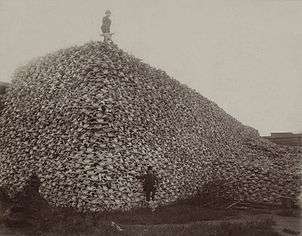
Humans, notably European settlers, were almost exclusively accountable for the near-extinction of the American bison in the 1800s. At the beginning of the century, tens of millions of bison roamed North America. Pioneers and settlers slaughtered an estimated 50 million bison during the 19th century, although the causes of decline and the numbers killed are disputed and debated.[71][72] Railroads were advertising "hunting by rail", where trains encountered large herds alongside or crossing the tracks. Men aboard fired from the train's roof or windows, leaving countless animals to rot where they died.[73] This overhunting was in part motivated by the U.S. government's desire to limit the range and power of indigenous plains Indians whose diets and cultures depended on the buffalo herds.[74] The overhunting of the bison reduced their population to hundreds.[75] Attempts to revive the American bison have been highly successful; farming has increased their population to nearly 150,000. The American bison is, therefore, no longer considered an endangered species.[75]
As of July 2015, an estimated 4,900 bison lived in Yellowstone National Park, the largest U.S. bison population on public land.[76] During 1983–1985 visitors experienced 33 bison-related injuries (range = 10–13/year), so the park implemented education campaigns. After years of success, five injuries associated with bison encounters occurred in 2015, because visitors did not maintain the required distance of 75 ft (23 m) from bison while hiking or taking pictures.[77]
Nutrition
Bison is an excellent source of complete protein and a rich source (20% or more of the Daily Value, DV) of multiple vitamins, including riboflavin, niacin, vitamin B6, and vitamin B12, and is also a rich source of minerals, including iron, phosphorus, and zinc. Additionally, bison is a good source (10% or more of the DV) of thiamine.
| Nutritional value per 100 g (3.5 oz) | |
|---|---|
| Energy | 180 kcal (750 kJ) |
0.00 g | |
| Sugars | 0 g |
| Dietary fiber | 0 g |
8.62 g | |
| Saturated | 3.489 g |
| Monounsaturated | 3.293g |
| Polyunsaturated | 0.402 g |
25.45 g | |
| Vitamins | Quantity %DV† |
| Thiamine (B1) | 12% 0.139 mg |
| Riboflavin (B2) | 22% 0.264 mg |
| Niacin (B3) | 40% 5.966 mg |
| Vitamin B6 | 31% 0.401 mg |
| Folate (B9) | 4% 16 μg |
| Vitamin B12 | 102% 2.44 μg |
| Vitamin D | 0% 0 IU |
| Vitamin E | 1% 0.20 mg |
| Vitamin K | 1% 1.3 μg |
| Minerals | Quantity %DV† |
| Calcium | 1% 14 mg |
| Iron | 25% 3.19 mg |
| Magnesium | 6% 23 mg |
| Phosphorus | 30% 213 mg |
| Potassium | 8% 353 mg |
| Sodium | 5% 76 mg |
| Zinc | 56% 5.34 mg |
| |
| †Percentages are roughly approximated using US recommendations for adults. Source: USDA Nutrient Database | |
Livestock
The earliest plausible accounts of captive bison are those of the zoo at Tenochtitlan, the Aztec capital, which held an animal the Spaniards called "the Mexican bull".[78] In 1552, Francisco Lopez de Gomara described Plains Indians herding and leading bison like cattle in his controversial book, Historia general de las Indias. Gomara, having never visited the Americas himself, likely misinterpreted early ethnographic accounts as the more familiar pastoralist relationship of the Old World.[79] Today, bison are increasingly raised for meat, hides, wool, and dairy products. The majority of bison in the world are raised for human consumption or fur clothing. Bison meat is generally considered to taste very similar to beef, but is lower in fat and cholesterol, yet higher in protein than beef, which has led to the development of beefalo, a fertile hybrid of bison and domestic cattle. A market even exists for kosher bison meat; these bison are slaughtered at one of the few kosher mammal slaughterhouses in the U.S. and Canada, and the meat is then distributed worldwide.[80][81][82]
In America, the commercial industry for bison has been slow to develop despite individuals, such as Ted Turner, who have long marketed bison meat. In the 1990s, Turner found limited success with restaurants for high-quality cuts of meat, which include bison steaks and tenderloin.[83] Lower-quality cuts suitable for hamburger and hot dogs have been described as "almost nonexistent".[83] This created a marketing problem for commercial farming because the majority of usable meat, about 400 pounds for each bison, is suitable for these products.[83] In 2003, the United States Department of Agriculture purchased $10 million worth of frozen overstock to save the industry, which would later recover through better use of consumer marketing.[84] Restaurants have played a role in popularizing bison meat, like Ted's Montana Grill, which added bison to their menus. Ruby Tuesday first offered bison on their menus in 2005.[84]
In Canada, commercial bison farming began in the mid-1980s, concerning an unknown number of animals then.[82] The first census of the bison occurred in 1996, which recorded 45,235 bison on 745 farms, and grew to 195,728 bison on 1,898 farms for the 2006 census.[82]
Several pet food companies use bison as a red meat alternative in dog foods. The companies producing these formulas include Natural Balance Pet Foods, Freshpet, the Blue Buffalo Company, Solid Gold, Canidae, and Taste of the Wild.
See also
- Bison hunting
- National Bison Day (1 November in the United States)
- Yellowstone Park bison herd
- Pile of Bones was the original name for Regina, Saskatchewan and referred to bison bones found nearby.[85]
References
- Biolib.cz, Genus - Bisons
- Olson, Wes. "Bison". The Canadian Encyclopedia. Archived from the original on 17 March 2014. Retrieved 23 April 2013.
- "BIson americanus pennsylvanicus". ITIS. Archived from the original on 14 March 2017. Retrieved 13 March 2017.
- Gennady G. Boeskorov, Olga R. Potapova, Albert V. Protopopov, Valery V. Plotnikov, Larry D. Agenbroad, Konstantin S. Kirikov, Innokenty S. Pavlov, Marina V. Shchelchkova, Innocenty N. Belolyubskii, Mikhail D. Tomshin, Rafal Kowalczyk, Sergey P. Davydov, Stanislav D. Kolesov, Alexey N. Tikhonov, Johannes van der Plicht, 2016, The Yukagir Bison: The exterior morphology of a complete frozen mummy of the extinct steppe bison, Bison priscus from the early Holocene of northern Yakutia, Russia, pp.7, Quaternary International, Vol.406 (June 25, 2016), Part B, pp.94-110
- "American Bison", The National Wildlife Federation.
- Semenov U.A. of WWF-Russia, 2014, "The Wisents of Karachay-Cherkessia", Proceedings of the Sochi National Park (8), pp.23-24, ISBN 978-5-87317-984-8, KMK Scientific Press
- Hendricks, K. "Bison bonasus, European bison", Animal Diversity Web, 2013.
- Joel Berger; Carol Cunningham (June 1994). Bison: mating and conservation in small populations. Columbia University Press. p. 162. ISBN 978-0-231-08456-7.
- Brink, Jack W. (2008). Imagining Head-Smashed-In: Aboriginal Buffalo Hunting on the Northern Plains (PDF). Athabasca University Press. ISBN 978-1-897425-09-1. Archived (PDF) from the original on 16 December 2011.
- "Chernobyl's Przewalski's horses are poached for meat". BBC. Archived from the original on 31 December 2016. Retrieved 13 March 2017.
- "Bison bison". IUCN Red List of Threatened Species. Archived from the original on 7 April 2017. Retrieved 13 March 2017.
- "U.S. Fish and Wildlife Service Species Report". Archived from the original on 19 October 2011. Retrieved 3 June 2009.
- "Wood Bison". U.S. Fish & Wildlife Service ECOS Environmental Conservation Online System. Archived from the original on 14 March 2017. Retrieved 13 March 2017.
- The Penny Cyclopædia of the Society for the Diffusion of Useful Knowledge by Society for the Diffusion of Useful Knowledge (Great Britain), published by C. Knight, 1835
- Sapp, Rick (2006). Trophy Bowhunting: Plan the Hunt of a Lifetime and Bag One for the Record Books (illustrated ed.). Stackpole. ISBN 978-0-8117-3315-1.
- Lott, Dale F. (2003). American Bison: A Natural History. University of California Press. ISBN 978-0-520-24062-9.
- Newman, Edward, ed. (1859). "Notice of the Various Species of Bovine Animals". The Zoologist. 17: 6362. Archived from the original on 6 July 2014.
- Verkaar, Edward L. C.; Nijman, Isaäc J.; Beeke, Maurice; Hanekamp, Eline; Lenstra, Johannes A. (22 January 2004). "Maternal and Paternal Lineages in Cross-Breeding Bovine Species. Has Wisent a Hybrid Origin?". Molecular Biology and Evolution. 21 (7): 1165–1170. doi:10.1093/molbev/msh064. PMID 14739241. Archived from the original on 23 October 2016. Retrieved 30 May 2013.
- Guo, S.; Liu, J.; Qi, D.; Yang, J.; Zhao, X. (2006). "Taxonomic placement and origin of yaks: implications from analyses of mtDNA D-loop fragment sequences". Acta Theriologica Sinica. 26 (4): 325–330. Archived from the original on 8 March 2012.
- Verkaar, E.L.; Nijman, I.J.; Beeke, M.; Hanekamp, E.; Lenstra, J.A. (2004). "Maternal and Paternal Lineages in Cross-Breeding Bovine Species. Has Wisent a Hybrid Origin?". Molecular Biology and Evolution. 21 (7): 1165–70. doi:10.1093/molbev/msh064. PMID 14739241.
- Buntjer, J B; Otsen, M; Nijman, I J; Kuiper, M T R; Lenstra, J A (2002). "Phylogeny of bovine species based on AFLP fingerprinting". Heredity. 88 (1): 46–51. doi:10.1038/sj.hdy.6800007. PMID 11813106.
- Marsolier-Kergoat, Marie-Claude; Palacio, Pauline; Berthonaud, Véronique; Maksud, Frédéric; Stafford, Thomas; Bégouën, Robert; Elalouf, Jean-Marc (17 June 2015). "Hunting the Extinct Steppe Bison (Bison priscus) Mitochondrial Genome in the Trois-Frères Paleolithic Painted Cave". PLOS One. 10 (6): e0128267. doi:10.1371/journal.pone.0128267. ISSN 1932-6203. PMC 4471230. PMID 26083419.
- Kurosawa Y. "モノが語る牛と人間の文化 - ② 岩手の牛たち" (PDF). LIAJ News No.109: 29–31. Archived (PDF) from the original on 19 April 2016. Retrieved 6 April 2016.
- HASEGAWA Y.; OKUMURA Y.; TATSUKAWA H. (2009). "First record of Late Pleistocene Bison from the fissure deposits of the Kuzuu Limestone, Yamasuge,Sano-shi,Tochigi Prefecture,Japan" (PDF). Bull.Gunma Mus.Natu.Hist.(13): 47–52. Archived (PDF) from the original on 24 September 2015. Retrieved 6 April 2016.
- Palacio, Pauline; Berthonaud, Véronique; Guérin, Claude; Lambourdière, Josie; Maksud, Frédéric; Philippe, Michel; Plaire, Delphine; Stafford, Thomas; Marsolier-Kergoat, Marie-Claude (1 January 2017). "Genome data on the extinct Bison schoetensacki establish it as a sister species of the extant European bison (Bison bonasus)". BMC Evolutionary Biology. 17 (1): 48. doi:10.1186/s12862-017-0894-2. ISSN 1471-2148. PMC 5303235. PMID 28187706.
- Tong, Hao-Wen; Chen, Xi; Zhang, Bei (2017). "New fossils of Bison palaeosinensis (Artiodactyla, Mammalia) from the steppe mammoth site of Early Pleistocene in Nihewan Basin, China". Quaternary International. 445: 250–268. doi:10.1016/j.quaint.2016.07.033.
- McDonald, J., 1981. North American Bison, Their classification and Evolution. University of California Press, Berkeley, Los Angeles, London.
- Zazula, Grant D.; Hall, Elizabeth; Hare, P. Gregory; Thomas, Christian; Mathewes, Rolf; La Farge, Catherine; Martel, André L.; Heintzman, Peter D.; Shapiro, Beth (2017). "A middle Holocene steppe bison and paleoenvironments from the Versleuce Meadows, Whitehorse, Yukon, Canada" (PDF). Canadian Journal of Earth Sciences. 54 (11): 1138–1152. Bibcode:2017CaJES..54.1138Z. doi:10.1139/cjes-2017-0100. hdl:1807/78639.
- Post, Eric (11 August 2013). Ecology of Climate Change: The Importance of Biotic Interactions. Princeton University Press. ISBN 978-1400846139. Archived from the original on 11 January 2018.
- Soubrier, Julien; Gower, Graham; Chen, Kefei; Richards, Stephen M.; Llamas, Bastien; Mitchell, Kieren J.; Ho, Simon Y. W.; Kosintsev, Pavel; Lee, Michael S. Y. (18 October 2016). "Early cave art and ancient DNA record the origin of European bison". Nature Communications. 7: 13158. Bibcode:2016NatCo...713158S. doi:10.1038/ncomms13158. ISSN 2041-1723. PMC 5071849. PMID 27754477.
- Cooper, Alan. "How we discovered the 'Higgs bison', hiding in plain sight in ancient cave art". The Conversation. Archived from the original on 14 April 2017. Retrieved 14 April 2017.
- Guthrie, R. D., 1990. Frozen Fauna of the Mammoth Steppe: the Story of Blue Babe. University of Chicago Press: Chicago.
- Bell, C.J.; Lundelius, E.L.; Barnosky, A.D.; Graham, R.W.; Lindsay, E.H.; Ruez, D.R.; Semken, H.A.; Webb, S.D.; Zakrzewski, R.J. (2004). "The Blancan, Irvingtonian, and Rancholabrean mammal ages". In Woodburne, M.O. (ed.). Late Cretaceous and Cenozoic Mammals of North America: Biostratigraphy and Geochronology. New York: Columbia Univ. Press. pp. 232–314. ISBN 978-0-231-13040-0.
- Scott, E.; Cox, S.M. (2008). "Late Pleistocene distribution of Bison (Mammalia; Artiodactyla) in the Mojave Desert of Southern California and Nevada". In Wang, X.; Barnes, L.G. (eds.). Geology and Vertebrate Paleontology of Western and Southern North America. Los Angeles: Natural History Museum of Los Angeles County. pp. 359–382.
- Sanders, A.E.; Weems, R.E.; Albright III, L.B. (2009). "Formalization of the mid-Pleistocene "Ten Mile Hill beds" in South Carolina with evidence for placement of the Irvingtonian–Rancholabrean boundary". In Albright III, L.B. (ed.). Papers on Geology, Vertebrate Paleontology, and Biostratigraphy in Honor of Michael O. Woodburne. Flagstaff: Museum of Northern Arizona. pp. 369–375.
- Kurten, B; Anderson, E (1980). "Order Artiodactyla". Pleistocene mammals of North America (1st ed.). New York: Columbia University Press. pp. 295–339. ISBN 978-0-231-03733-4.
- Jefferson, G., 2001. "Rancho La Brea Bison". In: J. Harris (ed), Rancho La Brea: Death Trap and Treasure Trove. Terra 30(2): 33. Los Angeles Natural History Museum Foundation. p. 33.
- Hoganson, John. "Occurrence of the Giant Ice Age Bison, Bison latifrons, in North Dakota" (PDF). North Dakota Geological Survey Newsletter. 29 (2). Archived (PDF) from the original on 25 March 2009.
- Wilson, M.C.; Hills, L.V.; Shapiro, B. (2008). "Late Pleistocene northward-dispersing Bison antiquus from the Bighill Creek Formation, Gallelli Gravel Pit, Alberta, Canada, and the fate of Bison occidentalis". Canadian Journal of Earth Sciences. 45 (7): 827–59. Bibcode:2008CaJES..45..827W. doi:10.1139/E08-027.
- Lott, Dale F. (2002). American Bison: A Natural History. Berkeley: University of California Press. ISBN 978-0-520-23338-6.
- "Animals of the La Brea Tar Pits Timeline". La Brea Tar Pits & Museum. 24 June 2015. Archived from the original on 11 January 2018. Retrieved 14 March 2017.
- An Alaska volcano and DNA reveal the timing of bison's arrival in North America Archived 27 March 2017 at the Wayback Machine, Alaska Dispatch News, Yereth Rosen, 27 March 2017. Retrieved 28 March 2017.
- Fossil and genomic evidence constrains the timing of bison arrival in North America Archived 19 March 2017 at the Wayback Machine, Proceedings of the National Academy of Sciences of the United States of America, Duane Froese et al, 20 December 2017. Retrieved 28 March 2017.
- Halbert, N.; Gogan, P.; Hiebert, R.; Derr, J. (2007). "Where the buffalo roam: The role of history and genetics in the conservation of bison on U.S. federal lands". Park Science. 24 (2): 22–29. Archived from the original on 3 March 2013.
- Polziehn, R.; Strobeck, C.; Sheraton, J.; Beech, R. (1995). "Bovine mtDNA Discovered in North American Bison Populations". Conservation Biology. 9 (6): 1638–1643 (1642). doi:10.1046/j.1523-1739.1995.09061638.x.
- Ranglack DH, Dobson LK, du Toit JT, Derr J (17 December 2015). "Genetic Analysis of the Henry Mountains Bison Herd". PLOS One. 10 (12): e0144239. Bibcode:2015PLoSO..1044239R. doi:10.1371/journal.pone.0144239. PMC 4682953. PMID 26673758.
- Mary Meagher, Margaret E. Meyer (September 1994). "On the Origin of Brucellosis in Bison of Yellowstone National Park: A Review". Conservation Biology. 8 (3): 645–653. doi:10.1046/j.1523-1739.1994.08030645.x. JSTOR 2386505.
- McMillan, B. R.; Cottam, M. R.; Kaufman, D. W. (2000). "Wallowing Behavior of American Bison (Bos bison)". American Midland Naturalist. 144 (1): 159–167. doi:10.1674/0003-0031(2000)144[0159:wboabb]2.0.co;2. JSTOR 3083019.
- "Anthrax kills bison in southern N.W.T." CBC.CA. 8 July 2006. Archived from the original on 6 January 2009.
- American Bison. nps.gov
- Ludwig N. Carbyn; S. Oosenbrug; D. W. Anions; Canadian Circumpolar Institute (1993). Wolves, bison and the dynamics related to the Peace-Athabasca Delta in Canada's Wood Buffalo National Park. Canadian Circumpolar Institute. ISBN 978-0-919058-83-5. Retrieved 10 July 2012.
- Robbins, Jim (1 April 2013). "On the Montana Range, Efforts to Restore Bison Meet Resistance". The New York Times. Archived from the original on 2 April 2013. Retrieved 2 April 2013.
- Jawort, Adrian (17 April 2013). "Shot, Left to Rot: Montana Officials Kill Bison Bull Wandering Outside Yellowstone National Park". Indian Country Today. Archived from the original on 18 April 2013. Retrieved 18 April 2013.
- "Montana Governor Vetoes Three Anti-Bison Bills, Lets the Hunt Stand". Indian Country Today Media Network. Archived from the original on 22 May 2013. Retrieved 17 June 2013.
- Craine, Joseph M.; Towne, E. Gene; Miller, Mary; Fierer, Noah (16 November 2015). "Climatic warming and the future of bison as grazers". Scientific Reports. 5 (1): 16738. doi:10.1038/srep16738. ISSN 2045-2322. PMC 4645125. PMID 26567987.
- Leonard, Joshua L.; Perkins, Lora B.; Lammers, Duane J.; Jenks, Jonathan A. (2017). "Are Bison Intermediate Feeders? Unveiling Summer Diet Selection at the Northern Fringe of Historical Distribution". Rangeland Ecology & Management. 70 (4): 405–410. doi:10.1016/j.rama.2017.01.005.
- Painter, Luke E.; Ripple, William J. (2012). "Effects of bison on willow and cottonwood in northern Yellowstone National Park". Forest Ecology and Management. 264: 150–158. doi:10.1016/j.foreco.2011.10.010.
- Frank, Douglas A.; McNaughton, Samuel J.; Tracy, Benjamin F. (1 July 1998). "The Ecology of the Earth's Grazing Ecosystems". BioScience. 48 (7): 513–521. doi:10.2307/1313313. ISSN 0006-3568. JSTOR 1313313.
- Allred, Brady W.; Fuhlendorf, Samuel D.; Engle, David M.; Elmore, R. Dwayne (1 October 2011). "Ungulate preference for burned patches reveals strength of fire–grazing interaction". Ecology and Evolution. 1 (2): 132–144. doi:10.1002/ece3.12. ISSN 2045-7758. PMC 3287302. PMID 22393490.
- Baskin, Leonid; Danell, Kjell (17 April 2013). Ecology of ungalates. Springer Science & Business Media. ISBN 9783662068205. Archived from the original on 11 January 2018. Retrieved 15 January 2017.
- Craine; et al. (2013). "Precipitation timing and grazer performance in a tallgrass prairie". Oikos. 122 (2): 191–198. doi:10.1111/j.1600-0706.2012.20400.x.
- Hamel, Sandra (2012). "Maternal allocation in bison: co-occurrence of senescence, cost of reproduction, and individual quality". Ecological Applications. 22 (5): 1628–1639. doi:10.1890/11-2181.1. PMID 22908718.
- Newell, Toni Lynn; Anna Bess Sorin. "ADW: Bison bison: Information". Animal Diversity Web at the University of Michigan. Archived from the original on 24 June 2013. Retrieved 21 June 2013.
- Durham, Sharon (2010). "Figuring out puzzling animal diseases". Agricultural Research. 58 (4): 12–13. Archived from the original on 5 April 2010.
- "Island Named for Antelope, the Bison". Utah.com. Archived from the original on 3 June 2013. Retrieved 30 May 2013.
- "Actual, and Potential Threats". European Bison Conservation Center. Archived from the original on 4 September 2012. Retrieved 17 June 2013.
- Champlain, Samuel, Henry P. Biggar. 1929. The Works of Samuel de Champlain, vol 3. Toronto: Champlain Society. p. 105.
- The American Heritage Dictionary of the English Language, Fourth Edition.
- Driver, Harold E. (1969). Indians of North America, 2d edition, revised. The University of Chicago Press.
- Lame Deer, John (Fire) and Richard Erdoes. (1994). Lame Deer, Seeker of Visions. Simon & Schuster. ISBN 978-0671888022
- "American Bison, Bison bison". National Geographic. Archived from the original on 20 June 2013. Retrieved 16 June 2013.
- Robbins, Jim (16 November 1999). "Historians Revisit Slaughter on the Plains". The New York Times. ISSN 0362-4331. Retrieved 26 December 2019.
- "Where the Buffalo No Longer Roamed". Smithsonian.com. Archived from the original on 10 March 2017. Retrieved 18 March 2017.
- Isenberg. The Destruction of the Bison. p. 136-7, 151-2.
- "Are Bison an Endangered Species?". Fermilab Science Education Office. Leon M. Lederman Science Education Center, Fermilab. Archived from the original on 27 September 2013. Retrieved 21 June 2013.
- Geremia C, Wallen R, White PJ. Population dynamics and adaptive management of Yellowstone bison. Archived 28 March 2016 at the Wayback Machine Mammoth Hot Springs, WY: Yellowstone National Park, National Park Service; 2015.
- Cherry, C; Leong, K; Wallen, R; Buttke, D (2016). "Notes from the Field. Injuries Associated with Bison Encounters — Yellowstone National Park, 2015". MMWR Morb Mortal Wkly Rep. 65: 293–294. doi:10.15585/mmwr.mm6511a5.
- Nicholson, Henry B. (1955). "Montezuma's Zoo". Pacific Discovery. 8/4: 3–11.
- Latcham, Ricardo E. (1922). Los animales domesticos de la America pre-Columbiana. Santiago, Chile: Museo de Etnologia y Antropologia Publication 3; Cervantes. pp. 150–151.
- "Bison from Farm to Table". USDA. Retrieved 6 January 2017.
- "| National Bison Association". Bisoncentral.com. Archived from the original on 20 January 2011. Retrieved 19 February 2011.
- Terry Kremeniuk. "Bison Farming". Canadian Encyclopedia. Historica-Dominion. 2012. Retrieved 18 June 2013, from HighBeam Research: "About Questia | Questia, Your Online Research Library". Archived from the original on 11 June 2014. Retrieved 18 June 2013.
- Haddad, Charles. "Bison Meat Slow to Catch On, But Turner Sees Promise". Knight Ridder/Tribune Business News. McClatchy-Tribune Information Services. 1999. Retrieved 18 June 2013, from HighBeam Research: "About Questia | Questia, Your Online Research Library". Archived from the original on 11 June 2014. Retrieved 18 June 2013.
- Bone, Eugenia. "Bison's back: bravo for buffalo. We're saving the Western icon by eating it (again).(The next frontier)." Sunset. Sunset Publishing Corp. 2008. Retrieved 18 June 2013, from Questia Online Library: "Bison's Back: Bravo for Buffalo. We're Saving the Western Icon by Eating It (Again)" by Bone, Eugenia - Sunset, Vol. 220, Issue 2, February 2008 | Online Research Library: Questia Reader". Retrieved 18 June 2013.
- "Regina". 17 September 2013. Archived from the original on 4 November 2016. Retrieved 3 November 2016.
Further reading
- Boyd, D (2003) "Conservation of North American Bison: Status and Recommendations". Master's dissertation, University of Calgary
- Cunfer, Geoff and Bill Waiser. Bison and People on the North American Great Plains: A Deep Environmental History. College Station, TX: Texas A&M University Press, 2016.
- Halbert, N; Derr, J (1995). "A Comprehensive Evaluation of Cattle Introgression into US Federal Bison Herds". Journal of Heredity. 98 (1).
- Nesheim, David A (2012). "Profit, Preservation, and Shifting Definitions of Bison in American". Environmental History. 17 (3): 547–77. doi:10.1093/envhis/ems048.
- Ward, T. J.; Bielawski, J. P.; Davis, S. K.; Templeton, J. W.; Derr, J. N. (1999). "Identification of Domestic Cattle Hybrids in Wild Cattle and Bison Species: A General Approach Using mtDNA Markers and the Parametric Bootstrap". Animal Conservation. 2: 51–57. doi:10.1111/j.1469-1795.1999.tb00048.x.
External links
| Wikimedia Commons has media related to Bison. |
| Wikisource has the text of the 1911 Encyclopædia Britannica article Bison. |
